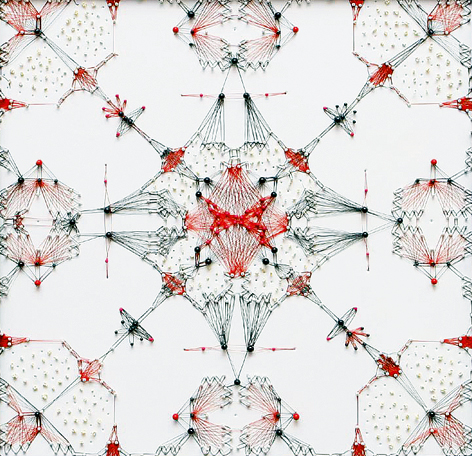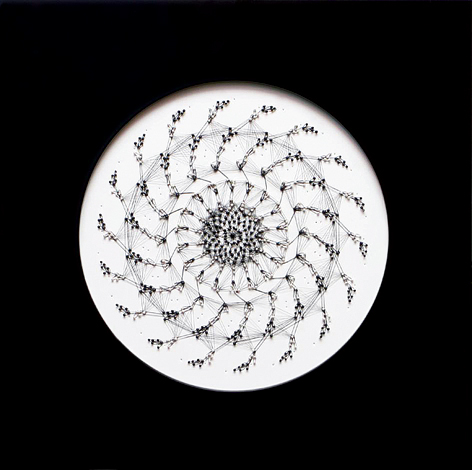|
|
 An Exquisite Hybrid An Exquisite Hybrid Iliana Veinberga, Art Critic Gundega Strautmane. "Dot...Line" 20.02.-06.03.2009. Agija Sūna's Art Gallery | |
|
Gundega Strautmane's exhibition Dot...Line (‘Punkts...līnija') was an original and noteworthy event in Latvian art life, as it was one of the rare occasions when the cultural community was presented with an opportunity to enjoy semantically rich art, which not only in its content, but largely even in the motivation of its creation and its physical existence highlights certain issues that have historically been and still are relevant in the local cultural discourse - for example, matters concerning the categories and boundaries of design, crafts, visual and conceptual art, and the phenomenology of art perception. For a number of reasons, education in textile art in Latvia is dominated by a historical tendency. Gundega Strautmane also has been through the process of sitting at the loom and weaving tapestries. At the same time, however, she has sought ways of communicating the spirit of textile art to her contemporaries - people whose understanding was important to her at the time, but who had found it difficult to appreciate the finer points of tapestry. The works shown at the exhibition are the result of this search for an alternative. These are more than ten seemingly decorative units made in the artist's own technique: little beads arranged on a modestly sized piece of paper in a definite symmetrical system, with a fine thread woven in between them to outline the ornamental rhythms. Fibre is used in the creation of the work, and the technique resembles bobbin lacemaking, which places the artist's creations within the artisan crafts tradition of textile art. This approach is also validated by the fact that ornamental pattern plays an important role in Strautmane's art, even though its presence in her work is itself a paradoxical event. | |
 Gundega Strautmane. Dot... Line... Futurism... 46x46cm. 2007. Photo: Mārtiņš Ziders | |
|
That is, she sees her professional future in textile design - contemporary, experimental and industrial; however, during her design studies in Germany the artist realized she was also greatly attracted to decorative symmetry, patterns and ornamentation, which her conceptually-oriented school was not inclined to accept as "design". Visiting the memorial exhibition of Ansis Cīrulis cemented belief in her true interest in textiles, and the result, as the artist herself says, is this: instead of giving three portfolios to her clients, she started bringing just one - the one that contained a mixture of visual art, digital graphics and textile design works. In this aspect, Strautmane's creative activities could make for an interesting subject for analysis within the framework of the feminist discourse, because through the ages various kinds of handicrafts have always been the vehicle for women's aesthetic sense and self-expression. Even though Gundega Strautmane's works can be considered as "the modernization of tradition", their ornamental patterns are distinctive and significantly different from the traditional form. The artist has used Braille characters to transcribe phrases from Christian prayers, writing them out in raised, tactile beads. These sets of bead characters are arranged in a symmetrical rhythm, both spelling out the text of the prayer and creating an impressive, decorative pattern. As a result, the works are an illustration of a classic conceptualist path, with an unexpected twist: the text is first of all made into a threedimensional physical structure. It may be read and its content perceived only through touch; repetitions and the ornamental arrangement of sets of repetitions provide not just a literary experience, but a sensually aesthetic one as well. | |
 Gundega Strautmane. Dona Norbis Pacem. 46x46cm. 2009. Photo: Mārtiņš Ziders | |
|
A large part of society does not possess the specific skill of reading Braille, therefore the meaning of the text is not accessible to these people and the physical structure or the text itself serves merely as an attractive, ornamental decoration. However, it is suggested to the viewer that this ornamental form is a prayer, hence a specific Christian and historical context is brought into play when viewing the work. The religious perspective kick-starts the imagination, and the rhythmical, centric structures encourage thoughts of cosmic order, the vastness of the Universe, the cyclic aspect of nature etc. - time-less categories that religion operates with, either directly or indirectly. This level, in turn, is not available to those who have to use Braille in their everyday communication. On the whole, the author has created works of art that are not just visually and technologically impressive - they are also hybrids with several layers of meaning. These works can be enjoyed by partially sighted and blind people, for whom the visual arts are generally not accessible. The artist has tested her works at Strazdumuiža boarding school and the Jugla Home for the Blind, to find out whether they qualify as art that is accessible to the sightless. This unique process motivated Gundega Strautmane to give further thought to other options of creating experiences equivalent to aesthetic enjoyment. The need to touch the works of art, to feel them, brings a new, rarely used perspective to the perception of art: tactile sensations and the emotions, and the reflections they provoke. Undeniably, the sense of touch may not be a priority to a fully sighted person, therefore it would be extremely interesting to have to develop this ability in order to perceive a work of art in all its multi-dimensional completeness. It seems the world of art would only become richer for it. /Translator into English: Līva Ozola/ | |
| go back | |







